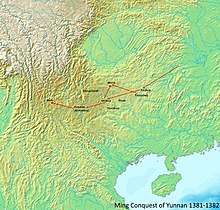Ming conquest of Yunnan
The Ming conquest of Yunnan was the final phase in the Ming dynasty expulsion of Mongol-led Yuan dynasty rule from China proper in the 1380s.
| Ming conquest of Yunnan | |||||||
|---|---|---|---|---|---|---|---|
| Part of the military conquests of the Ming dynasty | |||||||
 Ming conquest of Yunnan 1381-1382 | |||||||
| |||||||
| Belligerents | |||||||
| Ming dynasty |
Yuan remnants in Yunnan House of Duan | ||||||
| Commanders and leaders | |||||||
|
Hongwu Emperor Fu Youde Lan Yu Mu Ying |
Basalawarmi Duan Gong | ||||||
| Strength | |||||||
| 250,000[2] | Thousands of Mongol and Chinese Muslim troops | ||||||
| Casualties and losses | |||||||
| Thousands killed, hundreds of castrations | |||||||
Background
The Hongwu Emperor sent to Yunnan in 1369, 1370, 1372, 1374, and 1375 asking for its surrender. Some of the envoys were killed and this was the pretext under which an invasion was launched against Yuan-held Yunnan.[3]
War
Some 250,000 to 300,000 Chinese and Hui Muslim troops were mobilized to crush the remaining Yuan held territory in Yunnan in 1381.
The Ming General Fu Youde led the attack on the Mongol and Yuan Muslim forces. Also fighting on the Ming side were Generals Mu Ying and Lan Yu, who led Ming loyalist Muslim troops against Yuan loyalist Muslims.[4]
The Prince of Liang, Basalawarmi, committed suicide on January 6, 1382, as the Ming dynasty Muslim troops overwhelmed the Yuan Mongol and Muslim forces. Mu Ying and his Muslim troops were given hereditary status as military garrisons of the Ming dynasty and remained in the province.[5]
Aftermath
Duan Gong, whose ancestors were the rulers of the Dali Kingdom prior to the Mongol conquest, and had administrated the region under the Yuan dynasty, refused to accept Ming administration. He made it clear that Dali could only be a tributary to the Ming. Fu Youde attacked and crushed Duan Gong's realm after a fierce battle. The Duan brothers were taken captive and escorted back to the Ming capital.[6]
The Ming Generals Lan Yu and Fu Youde castrated 380 captured Mongolian and Muslim captives after the war.[7] This led to many of them becoming eunuchs and serving the Ming Emperor.[8] One of the eunuchs was Zheng He.[9]
In western Yunnan and Guizhou, Ming Chinese soldiers also crushed local rebellions. The Ming soldiers then married local Chinese, Miao, and Yao women; their descendants are called "Tunbao", in contrast to newer Chinese colonists who moved to Yunnan in later centuries. The Tunbao still live in Yunnan today.[10]
See also
References
- Frederick W. Mote; Denis Twitchett (26 February 1988). The Cambridge History of China: Volume 7, The Ming Dynasty, 1368-1644. Cambridge University Press. pp. 144–. ISBN 978-0-521-24332-2.
- Dardess 2012, p. 6.
- Yang 2008a.
- Tan Ta Sen, Dasheng Chen (2009). Cheng Ho and Islam in Southeast Asia. Institute of Southeast Asian Studies. p. 170. ISBN 981-230-837-7. Retrieved 2010-06-28.
- Michael Dillon (1999). China's Muslim Hui community: migration, settlement and sects. Richmond: Curzon Press. p. 34. ISBN 0-7007-1026-4. Retrieved 2010-06-28.
- Du Yuting; Chen Lufan. "Did Kublai Khan's conquest of the Dali Kingdom give rise to the mass migration of the Thai people to the south?" (PDF) (Institute for Asian Studies, Kunming ed.). Retrieved 2019-02-18. Cite journal requires
|journal=(help) - Journal of Asian history, Volume 25. O. Harrassowitz. 1991. p. 127. Retrieved 2011-06-06.
- Shih-shan Henry Tsai (1996). The eunuchs in the Ming dynasty. SUNY Press. p. 14. ISBN 0-7914-2687-4. Retrieved 2010-06-28.
- Shoujiang Mi, Jia You (2004). Islam in China. 五洲传播出版社. p. 37. ISBN 7-5085-0533-6. Retrieved 2010-06-28.
- James Stuart Olson (1998). An ethnohistorical dictionary of China. Greenwood Publishing Group. p. 340. ISBN 0-313-28853-4. Retrieved 2010-06-28.
Bibliography
- Dardess, John (2012), Ming China 1368-1644 A Concise History of A Resilient Empire, Roman & Littlefield Publishers, Inc.
- Yang, Bin (2008a), "Chapter 3: Military Campaigns against Yunnan: A Cross-Regional Analysis", Between Winds and Clouds: The Making of Yunnan (Second Century BCE to Twentieth Century CE), Columbia University Press